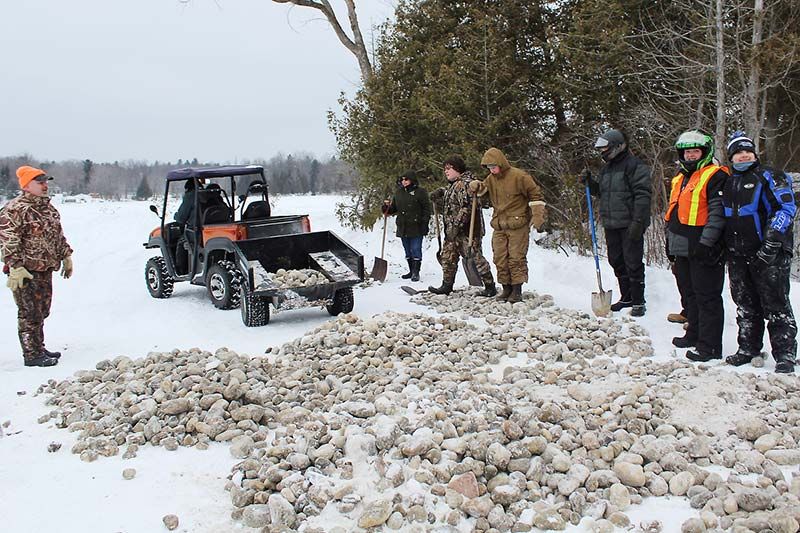Craig Bakay | Feb 06, 2019
When you think about, it’s kind of a mystery as to why we didn’t come up with this earlier.
It’s simple, the winter ice melts and anything that doesn’t float will sink to the bottom when it does.
That’s the principle behind a walleye spawning bed restoration project which took place on Long Lake last Saturday morning (February 2).
The big advantage of placing rocks that will form the (actually add to an existing) spawning bed on the ice is that they can be driven to the spot and placed rather precisely. When the ice melts in the spring, the rocks will sink.
On this day, the Long Lake Property Owners Association (LLPOA) members organized an army of snowmobiles, 4-wheelers and side-by-sides, all with sleds or trailers, to ferry the rocks out to locations, where other volunteers including the 1st Drummond Scouts Group, unloaded them and arranged them to correspond with the existing spawning beds.
“This is a great lake for this kind of project,” said Melissa Dakers of Watersheds Canada. “There’s no current to speak of and the two existing shoals get good wind.
“We’ve had other similar projects in Lanark that have worked out well.”
Dakers said the Algonquins of Ontario were also involved and they had funding from Fisheries and Oceans Canada through the Recreational Fisheries Conservation Partnership Program.
The rocks used are washed river stone, ranging in size from small apples to large grapefruit, supplied by contractor Peter Nedow. The beds themselves are marked with coniferous branches for safety.
Lake Steward Terry Eccles said they’ve done some spawning ground projects in the past through the MNR program, which no longer exists.
“So we contacted Melissa and she said she had some funding and all we needed to provide was some volunteers,” he said.
And provide the volunteers they did.
It was quite a sight to see: about 40 snowmobiles and ATVs hooked up with sleds and trailers, running a constant relay from the shore to the beds. In all, it took about two hours to completely move two large truckloads of rock.
“This increases the spawning area available to the walleye,” he said. “We’re really hoping this will make the walleye competitive with the bass.”
The rocks were deposited off two different islands (known walleye spawning beds) on the ice and will sink to the bottom when the ice melts in the spring.
More Stories
- The Sun Shines On The Parham Fair
- Creating Your Own Weather, Forever and Ever
- Silver Lake Pow Wow Set For A Big Year
- South Frontenac Receives Substantial Provincial Grant for their Verona Housing Project
- South Frontenac Council Report - August 12
- Dumping To Be Curtailed At Loughborough Waste Site
- Central Frontenac Inching Towards Increasing Severance Opportunities
- Addington Highlands Council Report - August 5
- Addington Highlands Council Report - August 12
- Addington Highlands Council Report - August 12

